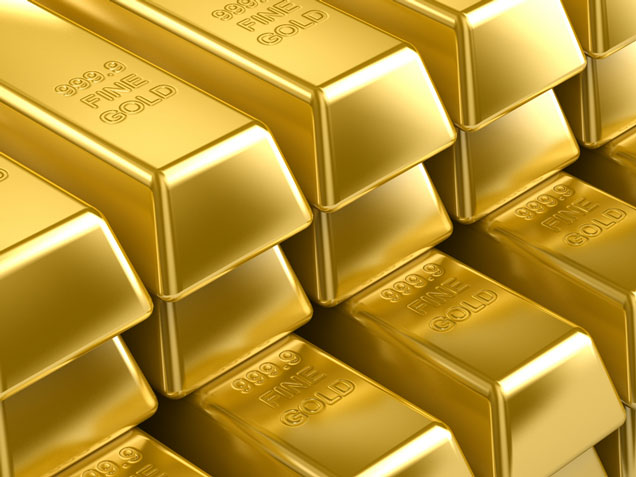The world economy is undergoing major shifts. On the back of a resurgent US economy and falling global demand, oil prices have hit four-year lows. But oil has not been the only victim of the dollar bill reclaiming its place: prices of gold have also fallen to their lowest level in almost five years, and that despite sustained strong demand from India and China.
While the collapse of global oil prices is already squeezing the Iranian government’s budget, it remains a question how the government will respond to the plummeting value of its gold reserves.
Global gold prices have been in slide since late 2012. As a global financial crisis hit in 2008-9, gold prices rapidly climbed from their 2008 low of $729.72 per ounce to an all-time high of $1,900.30 per ounce in the middle of the global economic turmoil on September 9, 2011, according to kitco.com.
Since the collapse of the Bretton Woods system in the seventies, gold and silver have acted as ultimate stores of value as the value of the prime global reserve and transaction currency, the US dollar, was deemed uncertain. Hence, the US dollar and global gold prices are closely and inversely linked.
Since spring this year (2014), the EU, the UK and other developed economies have lagged behind the US in terms of economic performance. Major currencies have lost value in relation to a resurgent dollar, which has in turn speeded up the decline in gold prices.
However, while global gold prices have returned to their pre-financial crisis levels, rial-denominated gold prices in Iran have risen sharply since the US and EU intensified financial and trade sanctions in 2012 and the rial lost nearly 70 percent of its value.
As sanctions became stiffer, Iran experienced major difficulties in accessing international money markets and conducting transactions, which are mostly denominated in dollars or euros. In order to keep on exporting oil, which the country relies on to reach budgetary obligations, Iran has been willing to trade in gold.
Though Iran does not disclose its gold reserves and has stopped producing reports of gold imports since 2009, unconfirmed reports show that the country has in recent years imported a significant amount of gold from India and Turkey in return for oil and gas, a process which due to its informal and complicated nature has also led to corruption and self-enrichment by some traders, according to the Rouhani administration.
Since last year, there has been a clampdown on this sort of sanctions-related corruption. Simultaneously, more light has been shed on the amount of gold reserves the Central Bank of Iran (CBI) holds.
Notably, several reports have been published in contradiction to the earlier information released by the CBI during the presidency of Mahmoud Ahmadinejad. Former governor of the CBI, Mahmoud Bahmani, told IRNA in 2011 that the country held 500 metric tons of gold reserves. However, upon exiting his post, he claimed that the reserves equalled only 108 metric tons, a fifth of the previously stated amount.
The collapse of the rial after 2012 has also led households to exchange the local currency for dollars and gold. Ebadollah Mohammad-vali, director of the Gold and Jewels Producers and Exporters Union, told Mehr news agency last September that over 100 metric tons of gold was being kept by Iranian households, while 2013 estimates claimed that the figure for the amount of money households held in foreign currencies amounted to $18 billion. Taken together, gold and foreign exchange in the hands of households are estimated to have been five times as large as the amount of gold kept in the CBI’s vault.
While over the past year the rial-dollar exchange rate has remained relatively stable, the global ascent of the US dollar in combination with speculation that the nuclear talks between Iran and the 5+1 group might fail, has slightly depressed the value of the rial in relation to the dollar. Currently the US dollar trades at 32,560 rial, while in late July, this number stood at 31,650; a 2.87 percent increase in the American currency’s value.
These figures show that the relative strengthening of the dollar against the rial has not been enough to offset the effect of slipping global gold prices. As a result, the value of gold in Iran, which is commonly traded in the form of coins, called sekeh in Persian, has kept on declining.
Unclear Reaction
Although the current fall in gold prices will most likely trigger households to reduce their gold reserves, it is far from clear how the government will react to the rapidly declining value of its reserves.
The International Energy Agency estimates that Iran has exported an average of 1.1 million crude oil barrels a day this year (2014). Brent oil prices currently stand at around $79, down by about 30 percent from its mid-June high of $115. The difference in daily revenue between the 2014 high and current prices is about $40.7 million. Both falling oil and gold prices have thus put strain on the already tight budget.
It is unlikely the government will take the risk of releasing large amounts of gold before a definite agreement on the nuclear issue is reached.
When Iran and the West reached a temporary agreement last year, sanctions on trading gold with the Islamic Republic were eased. Although fears that Iran might release large amounts of gold into the global gold market led to gold shedding as much as 1.5 percent of its value on the day of the agreement, these fears have proved largely unfounded. There has been no hard evidence that the CBI sold large amounts of gold since last year.
In another recent development, gold export regulations have been eased, suggesting that the Rouhani administration is trying to reduce government control over the metal’s in and outflows. However, these regulations are likely to affect domestic gold prices only minimally.


